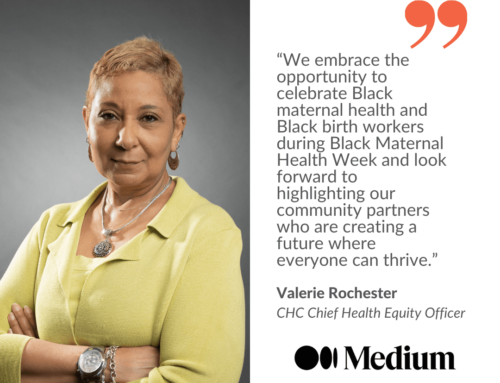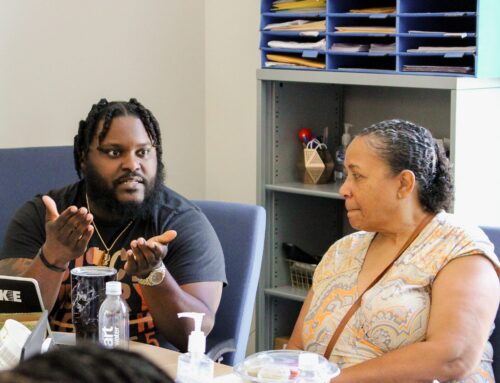Moving Past COVID-19 Through Vaccine Equity
By: Thomas G. Bognanno, President and CEO of CHC: Creating Healthier Communities
More than 31 million doses of the COVID-19 vaccine have been administered, according to the CDC’s most recent statistics. Despite this, approximately half of U.S. adults remain hesitant to receive the vaccine, but that number is only half of the story.
The Black community is being infected with COVID-19 and dying at higher rates, yet are less likely to vaccinate, further highlighting challenges to our nation’s health equity. Why is this occurring? Concerns related to safety and confidence are coupled with systemic issues of racism and inequities that affect access to vaccines.
A PEW Research Center poll found that just 42 percent of Black adults say they would definitely or probably get a COVID-19 vaccine, compared with 61 percent of White adults, 63 percent of Hispanics and 83 percent of Asian Americans. Further, Black Americans are more likely to live in areas where they have lower per capita access to pharmacies and other centers of distribution. This presents a conundrum for public health agencies rolling out vaccine programs.
So, what can your organization do?
Start addressing health inequity by offering workplace vaccination programs for employees and their families. Yes, legally companies can mandate the vaccine with some exceptions – including disability and religious beliefs – but employees who are vaccine-hesitant should be treated with compassion, sensitivity, and respect.
Employees may have different levels of comfort regarding the vaccine due to where they live, religion, politics, upbringing, personal experience, and government mistrust, to name a few reasons. Yet, the goal for employers is to be transparent and provide accurate information, encouraging health literacy.
Consider vaccinating credible influencers with your company to demonstrate vaccine confidence. Your company’s CEO or division leaders could receive the vaccine live streamed to increase employee morale around the vaccine debate and foster a feeling of shared commitment. Influential leaders from President Biden to former Vice President Pence to Queen Elizabeth have already gotten the vaccine.
Share the names of celebrities, athletes, politicians and other influencers who’ve gotten the vaccine as well as stories from those who it helped, such as employees with older parents who may be thrilled to have received the vaccine.
Offer incentives for vaccinations. Some companies are offering financial incentives for employees to get vaccinated. Paid time off, gift cards, or cash bonuses can result in earlier and more willing vaccinations from your employees. These incentives can supplement other policies that support COVID-related employee needs. Some barriers – such as scheduling or transportation – can be overcome through workplace initiatives.
Draw on your employee resource groups. These groups can give you insights into different employee groups and encourage thoughtfulness and inclusion in company programs and communications related to the vaccine.
Partner with trusted community-based nonprofit organizations, clinics, faith-based organizations and other groups that have established relationships with under-resourced communities and communities of color. These groups can often provide insight and support on all your company’s efforts, not just COVID-19 response or vaccinations.
Continue offering maximum flexibility for employees.
Distance learning, health challenges and other stressors during COVID-19 have put incredible pressure on many employees. Many teachers in the U.S. rate distance learning a 1-3 on a 10 scale, putting more pressure on parents. Millions of women, especially women of color, have left the workforce. Whenever possible, try to provide flexible hours and leave so employees can manage these challenges, as well as medical appointments and vaccinations. One example is Walmart supporting associates with emergency leave.
Encourage employee engagement and show your support for health equity through volunteering and supporting your community through opportunities like CHC’s #ForHealth Equity campaign. Good health is the great equalizer. Use these tools and resources to incorporate health equity awareness into your organization.
Check out these additional tools and resources:
- The CDC provides a COVID-19 Vaccine Communication Toolkit for Community-Based Organizations that includes FAQs, letters, social media graphics, and more.
- CDC COVID Data Tracker
- COVID-19 Vaccine Distribution: The Process | HHS.gov
- Supporting an Equitable Distribution of COVID-19 Vaccines – National Governors Association
- Administering COVID-19 Vaccines (walmart.com)
- Black Women’s Health Imperative’s survival guide and video series highlight the voices of Black Americans around the vaccine.
- March of Dimes released a statement on the vaccine for those pregnant and lactating.
- The American Heart Association details what heart and stroke patients should know about the vaccine.
- The American Cancer Society discusses the safety of the vaccine for those with cancer or history of cancer.
- Recently, the American Diabetes Association provided a vaccination guide broken down by state, as well as a list of FAQs, Rights for Workers with Diabetes, and more.
- Walmart offers a map with vaccine availability and eligibility info by state.
- Our Community Health Center offers resources such as Ensuring Equitable COVID-19 Distribution Through Internal Communications and Public-Private Partnership | CHC: Creating Healthier Communities (chcimpact.org)

Thomas G. Bognanno, President and CEO of CHC: Creating Healthier Communities
Thomas G. Bognanno has been the President and CEO of CHC: Creating Healthier Communities formerly Community Health Charities since January 2006. Prior to that, Tom had a distinguished 20-year career with the American Diabetes Association (ADA), where he served as the Chief Field Officer. He was instrumental in revitalizing ADA’s community-level infrastructure and acting as one of the chief architects of the Everyday Choices for a Healthier Life partnership between ADA, the American Heart Association, and the American Cancer Society. Before ADA, Tom spent six years with the American Cancer Society.
At CHC, Tom has been a catalyst for consolidating the organization and creating a new direction for its more than 2,000 charity partners nationwide and its network of over 17 million caring employees. Under Tom’s leadership, CHC evolved its mission to empower people to take action to improve health and wellbeing to build stronger, healthier communities. CHC supports education, treatment, and prevention for those with health challenges; brings organizations together to improve community health; provides individuals with opportunities to get involved; and increases the capacity of nonprofit organizations.
Residing in northern Virginia, Tom and his wife Suzan have been married for over 35 years and have raised three children







